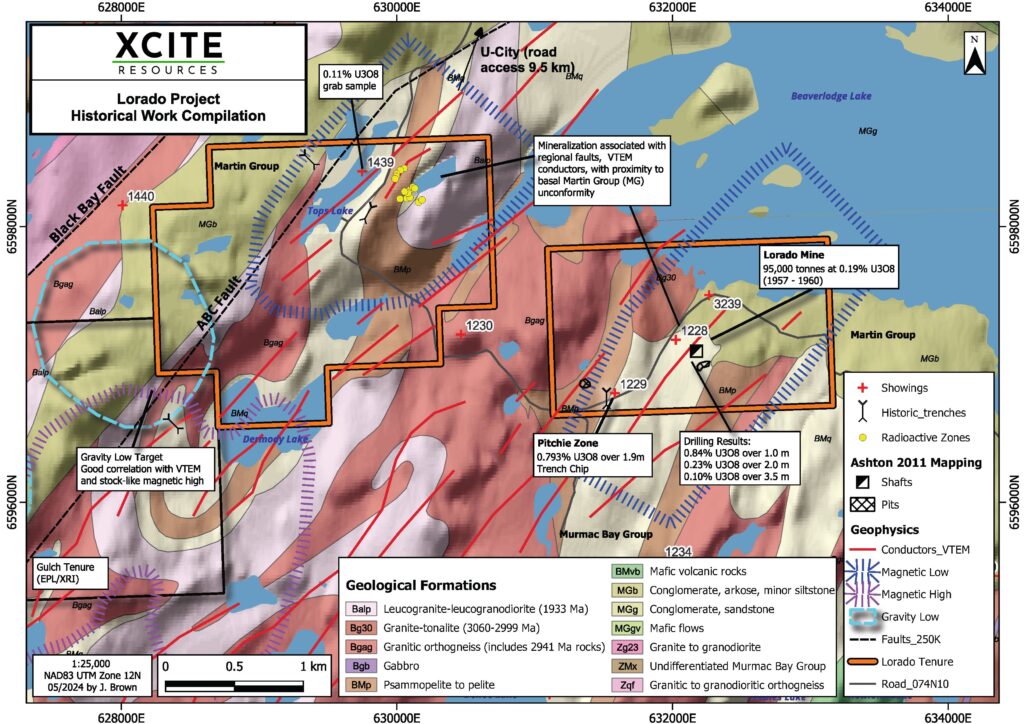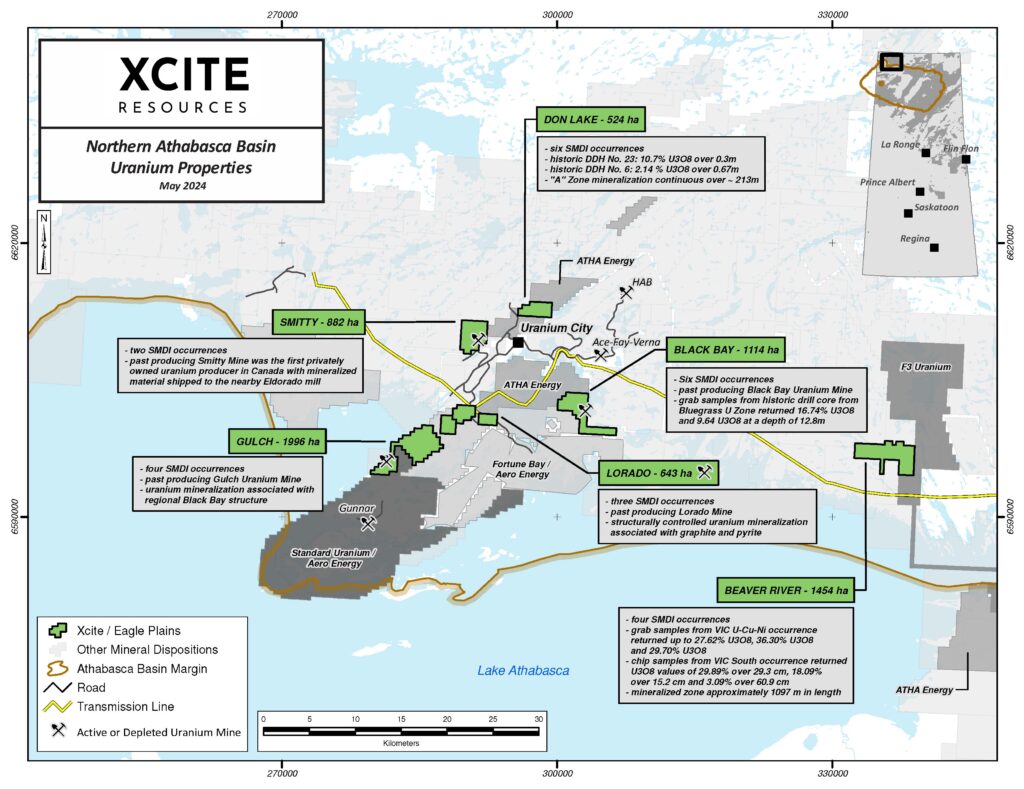Vancouver, British Columbia, May 27, 2024:Xcite Resources Inc. (CSE:XRI) (“XRI or Xcite”) and Eagle Plains Resources Ltd. (“EPL”:TSX-V, or “Eagle Plains”), have received the results from a data compilation on the Lorado uranium project, located 9.5 km SW of Uranium City, Saskatchewan. The road-accessible Lorado tenures cover the past producing Lorado mine, as well as three additional uranium occurrences. The compilation and interpretation of available data will lead to recommendations for 2024 fieldwork.
Lorado Data Compilation Highlights:
- Excellent infrastructure – road-accessible from Uranium City.
- Historical Lorado Mine reportedly produced 95,000 tonnes of 0.19% U3O8 from 1957-1960.
- Chip samples up to 0.793% U3O8 over 1.9 meters, outside of the Lorado Mine area.
- Overlapping airborne EM and gravity geophysical anomalies coincident with major structural zones are underexplored.

About the Lorado Project
The road-accessible 643ha project overlies 4 Saskatchewan Mineral Deposit Index (“SMDI”) occurrences including the historical Lorado Uranium Mine (SMDI 1228).
The Lorado property is on the western edge of the Beaverlodge domain. The Black Bay fault, a regional structure that is inferred to control uranium mineralization in the Beaverlodge camp, lies immediately to the west of the property. The dominant structure on the property is the ABC fault, which transects the Lorado west tenure.
Uranium mineralization is hosted in granitic gneisses and brecciated or mylonitized units from the Murmac Bay group rocks and is present typically in the form of pitchblende. The uranium mineralization has a strong spatial association to the well-developed fault systems on the tenures and is associated with graphite and sulphide mineralization.
The Lorado Uranium Mine (SMDI 1228) host rocks are highly altered and metamorphosed argillites containing chlorite and graphite. The structurally-controlled uranium mineralization occurs in graphitic schists within gently plunging ore shoots. The irregular ore shoots are up to 200 ft (60.96 m) long by 50 ft (15.2 m) wide with the highest-grade uranium mineralization occurring within a folded area on the limbs of a gently plunging syncline.
The Pitchie Uranium Zone 1, or Uranium Ridge Mine (SMDI 1229) is located 850m west-southwest of the Lorado Mine. Seven other minor zones occur in an area extending in a southwest-northeast direction around Pitchie Uranium Zone No. 1. The Main Zone occupies a shear zone that was traced on surface for a strike length of 300 ft (91.4 m). The vein material is banded with pitchblende and pyrite, as well as nolanite, an iron vanadium mineral. Most of the uranium occurrences are confined to a graphite schist that occupies much of the southern portion of the property. Pitchblende occurs mainly as veins in both the northeast and northwest-trending fractures in the graphite schist and interbedded quartzites. Chip sampling of the exposed No. 1 Zone returned up to 0.793% U3O8 over 1.88m (AF 74N07-0046).
Recent work on the Lorado was focused on the western part of the property in the area of the ABC Fault. Geophysical interpretation indicates that gravity anomalies show good correlation with strong electromagnetic (VTEM) responses and with NE-trending magnetic and structural zones, none of which have ever been drill-tested. The geological setting suggests the possibility for basement-hosted uranium mineralization.
Lorado History
The Lorado has a long history of exploration with 24 Assessment Files (AF) on the property in the Saskatchewan geological database. Pitchblende was first reported in the area in 1930 and between 1944 to 1948, prospectors discovered numerous radioactive showings in the Lorado area with John Ross staking claims in 1948. In 1952, the property was optioned to Consolidated Mining and Smelting Company of Canada who carried out geological mapping, prospecting, rock sampling and a 292m, 5-hole diamond drill program (AF 74N10-0192).
In 1953, historical work in the Lorado Mine area began by Lorado Uranium Mines Ltd. Geological mapping and radiometric surveys, diamond drilling, and initial level planning was completed. The first 4 holes were drilled in 1953, totalling 308m. Initial drilling results within the Lorado Mine area ranged from trace values up to 0.84% U3O8 over 1.0 m, 0.12% U3O8 over 2.0 m, 0.23% U3O8 over 2.0 m, and 0.10% U3O8 over 3.5 m (AF 74N07-0003). A shaft was completed in 1954, along with level and sub level development.
A treatment plant for the ore was completed in 1957 which had a production rating of 500 tons/day. Production was later increased to 800 tons/day. The mill processed mine and custom ore from other projects in the region. Between 1957 and 1960, an additional shaft with 4 levels was sunk and mining and milling was conducted and 95,000 tons grading 0.19% U3O8 was milled. The Lorado mine closed in 1960.
Various operators including Uranium Ridge Mines, Anuwon Uranium Mines, Atominerals Exploration and Imperial Mines and Metals were active in the Lorado area from 1954 – 1958, mainly focused on structurally controlled pitchblende mineralization associated with NE-striking faults containing graphite. Mineralization at the Pitchie Zone was discovered in 1951 and in 1954, Uranium Ridge completed a 91.4m trench over the main showing area, followed by 74 holes (6705.6m) of diamond drilling. The results of this work indicated that the Pitchie mineralization was likely a southern extension of the Lorado deposit, and in 1956 the Lorado extension was explored from the Lorado mine underground with 213m of development work and 1340.8m of diamond drilling.
In 1968, Gunnex Ltd. completed an electromagnetic (EM) geophysical survey and diamond drilling program in the general area of the Lorado Mine. A total of 307m in three holes were drilled to test three EM anomalies. Strongly graphitic structures were intersected, with moderate associated radioactivity reported.
There was a brief spike in activity in the Lorado area from 1978 – 1980 with Tobe Mines (drilling), Springfield Consulting (airborne EM geophysics) and Esso Minerals Canada (ground geophysics, drilling) completing work both in the area of the Lorado mine and in the western part of the current property.
Rod Dubnik acquired claims in the Lorado area in 1991, carrying our prospecting to determine the potential presence of kimberlites.
In 2010, JNR Resources completed a Full Tensor Gravity Gradiometer survey over part of the current Lorado property. A gravity low anomaly coincident with a strong VTEM response that correlates with
NE-trending magnetic and structural zones was located in the south western part of the property.
The most recent work on the property was by Fission 3.0 Corp. In 2017 Fission completed ground geophysical surveys, followed by prospecting and sampling. Multiple conductors were identified in the Dermody Lake area (western Lorado claim block). In 2019, Fission conducted prospecting, scintillometer surveying, and rock sampling around the Dermody Lake area. The prospecting program followed up historical VTEM conductors, with grab samples returning from trace values up to 135 ppm U from hematite altered granitoid rock.
Rock grab samples are selective samples by nature and as such are not necessarily representative of the mineralization hosted across the property. The above results were taken directly from the SMDI descriptions and assessment reports (AF) filed with the Saskatchewan government. Management cautions that historical results were collected and reported by past operators and have not been verified nor confirmed by a Qualified Person, but form a basis for ongoing work on the subject properties.

About the Beaverlodge Uranium District
The Don Lake, Black Bay, Don Lake, Gulch, Lorado, and Smitty projects are located in the Beaverlodge District near Uranium City in the Lake Athabasca region of Saskatchewan. Occurrences of uranium mineralization are abundant in the Uranium City area and have been explored and documented since the 1940s. The Beaverlodge camp was the first uranium producer in Canada, with historic production of approximately 70.25 million pounds of U3O8 completed between 1950-1982, with ore grades averaging 0.23% U3O8. The two largest producers were the Eldorado Beaverlodge (Ace-Fay-Verna) mine and the Gunnar uranium mine. The Beaverlodge area has seen limited uranium-focused exploration since the early 1990’s.
Beaverlodge-style uranium deposits host structurally-controlled, high-grade mineralization in veins and breccia-fills within basement rocks. Mineralization often occurs at geological contacts and consists of structures filled with hematite, chlorite and graphite associated with pitchblende.
Qualified Person
Technical information in this News Release has been reviewed and approved by C.C. Downie, P.Geo., a director and officer of Eagle Plains, hereby identified as the “Qualified Person” under N.I. 43-101.
About Xcite Resources Inc.
Xcite Resources is an early-stage exploration company working to become a leader in the discovery and development of energy transition metals. The uranium project portfolio in the Athabasca Basin will propel our efforts to achieve a high-grade discovery.
On behalf of the Board of Directors of Xcite Resources Inc.
Jean-Francois Meilleur, CEO
Contact:
CEO & Shareholder,
jfmeilleur@paradox-pr.ca
+1 514 951 2730
The Canadian Securities Exchange (CSE) has not reviewed and does not accept responsibility for the adequacy or the accuracy of the contents of this release.
Cautionary Note Regarding Forward-Looking Statements:
The CSE has neither approved nor disapproved the contents of this press release. Neither the CSE nor its Regulation Services Provider (as that term is defined in the policies of the CSE) accepts responsibility for the adequacy or accuracy of this press release. This press release contains statements that constitute “forward-statements.” Such forward-looking statements involve known and unknown risks, uncertainties and other factors that may cause the Company’s actual results, performance or achievements, or developments to differ materially from the anticipated results, performance or achievements expressed or implied by such forward-looking statements.
